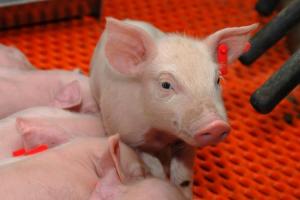Pig-ease: Using environmental control to help pigs adapt and grow
Environmental control in pig housing is important for animal growth and health. Modern farms have computer-controlled systems that are adjusted automatically to optimize the environment depending on the stage of growth or reproduction, based on ideal temperature curves established from research and models. For example, for growing pigs, temperature needs to decrease by set amounts as they increase in body weight. However, it is important to ensure the correct growth curve is selected in any automated system to account for breed, age and health of the animals.
When animals have been moved to new housing, perhaps following weaning, it may take several days for them to adjust to their surroundings and the new supply of water and feed, and feed intake may drop during this time. The environmental temperature will need to be held at a higher level, compared to their weaning shed, until they have adapted suitably and resumed consumption and growth. Therefore, although computer-controlled systems are very useful, management by personnel and suitable reactions regarding changes in the regulation of temperature are still key to ensuring the growth and health of the pigs.

Relative humidity
Relative humidity (RH) is defined as the ratio of air-water vapor at a specific temperature compared to the maximum amount of water vapour the air could hold, expressed as a percentage. Under normal, ambient temperatures, pigs can tolerate wide ranges of RH, although RH is still used to assess air quality in housing, and RH should be maintained between 60 percent and 90 percent. Nasal mucosa can be severely reduced in very dry housing conditions (low RH), leading to an increased risk of developing health problems from airborne pathogens, particularly those of the respiratory tract. Conversely, in wet conditions with higher RH, pathogens present in water droplets increase exposure to disease.
For nursery pigs, high RH can be a problem when the ambient air temperature is low, as automated ventilation systems reduce the amount of fresh air circulating within the house, allowing RH to increase to problematic levels. Under these conditions, an increase in respiratory disease can occur, which may affect the health and growth of the pigs. Intervention by management personnel is required under these conditions to ensure ventilation rates are maintained. Additional space heaters can be used to get the house up to temperature before moving the piglets.
In modern housing systems, both temperature and RH can be controlled automatically via sensors. However, care is needed with these, as they can become damaged during clean out and power washing. Their accuracy should be verified on a regular basis using handheld and empirical devices.
Learn more at the Pig Knowledge Hub.


